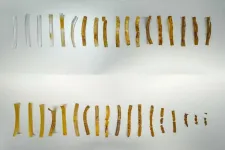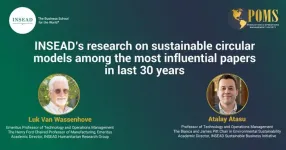(Press-News.org) ITHACA, N.Y. – Environmentalists rejoiced when China announced its commitment to reach carbon neutrality by 2060, but the decarbonization of China – which emits 27% of global carbon dioxide and a third of the world’s greenhouse gases – may come with hidden costs and hard environmental choices, according to new research.
In a paper published in Communications Earth & Environment, Stefano Galelli, associate professor at Cornell University’s School of Civil and Environmental Engineering, and colleagues attempt to quantify how decarbonizing the China Southern Power Grid, which provides electricity to more than 300 million people, will negatively impact river basins, most of which run from China into downstream countries, and will reduce the amount of cropland in China.
“If we think of any major technological change, they always have costs and unintended consequences,” Galelli said. “The sooner we realize and address them, the more sustainable and equitable the energy transition will be. We have to do it right.”
Decarbonizing the grid by 2060 may be technically feasible, but would require building several dams for hydropower production (roughly 32 GW) and converting about 40,000 square kilometers of cropland to support growth in solar and wind, Galelli said. Most of the dams would be placed on transboundary rivers, meaning those shared by two or more countries, resulting in potential negative ecological impacts in both China and downstream countries.
Two major transboundary river basins that will be impacted are the Salween and Mekong, both major biodiversity hotspots, Galelli said. The Salween is shared by China (upstream) and Myanmar; the Mekong by China (upstream), Myanmar, Thailand, Laos, Cambodia and Vietnam – thus the impacts of additional damming are shared.
Dams block the transport of sediments and nutrients from the upper reaches to the river mouth, and this reduces the productivity of ecosystems and fisheries. Blocking the transport of sediments also affects river deltas: If sediments do not reach the delta, saline intrusion becomes a bigger problem. Dams can also impact migratory fish species.
Decarbonization would also lead to ecological and sociological trade-offs in terms of land use, Galelli said.
“Excluding sites that are protected – cities and national parks, for instance – what you’re left with is cropland on which to build solar and wind power,” he noted.
Coal power plants have historically been the dominant source of electricity for the China Southern Power Grid – but building enough wind and solar arrays to replace the electricity supply guaranteed by conventional coal plants will take up a lot of space, Galelli said.
And that space required for the construction of solar and wind plants may not be equitably divvied up: Their research shows that 43% of the total land requirements would likely be focused on the Guangxi province, where crop and grassland constitute the vast majority of land. This might be a heavy burden for the province and result in significant ecological, social and financial costs to local communities.
As we make strides toward decarbonizing, he said, China is at the forefront.
“Doing it in strategic ways is very important. We have to start with ones that are less impactful,” Galelli said. “We can make decisions that balance decarbonization efforts with the protection of local communities, water and land resources.”
For additional information, see this Cornell Chronicle story.
END
China’s bid to decarbonize may have hidden costs
2024-04-30
ELSE PRESS RELEASES FROM THIS DATE:
Climate change and mercury pollution stressed plants for millions of years
2024-04-30
The link between massive flood basalt volcanism and the end-Triassic (201 million years ago) mass-extinction is commonly accepted. However, exactly how volcanism led to the collapse of ecosystems and the extinction of entire families of organisms is difficult to establish. Extreme climate change from the release of carbon dioxide, degradation of the ozone layer due to the injection of damaging chemicals, and the emissions of toxic pollutants, are all seen as contributing factors. One toxic element stands out: ...
Stowers Institute for Medical Research appoints new Assistant Investigator
2024-04-30
KANSAS CITY, MO—April 30, 2024—The Stowers Institute for Medical Research announces the appointment of Kamena Kostova, Ph.D., as its newest Principal Investigator. Kostova, an accomplished cellular and molecular biologist, will join the Institute in Fall 2024 as an Assistant Investigator. She brings with her an established research program focused on understanding cellular responses to ribosome breakdown and the relationship these responses have with complex diseases such as cancer and neurodegeneration.
Kostova is currently ...
Science council: “Tasks excellently fulfilled”
2024-04-30
The German Science and Humanities Council (Science Council) assessed the German Fed-eral Institute for Risk Assessment (BfR) in Berlin on 7 and 8 November 2023 and published its assessment today, 22 April 2024. As the highest German scientific commission, it certi-fies that the BfR “fulfills tasks of great social relevance” (protection of human health, in-forming the public about health risks posed by chemicals and biological substances) “on the basis of very good research”. It is characterised by an “extremely rapid response capability, a pronounced application orientation and a high degree of being up-to-date with its topics”. “We are delighted ...
USC-led study introduces a new and improved way to grow the cells that give rise to the kidney’s filtration system
2024-04-30
In a new study published in Cell Stem Cell, USC scientists report significant progress in cultivating nephron progenitor cells (NPCs), the cells destined to form the kidney’s filtration system, the nephrons. NPCs hold immense promise for understanding kidney development, modeling diseases, and discovering new treatments.
“By enhancing our capability to grow NPCs from human stem cells, we create a new avenue for understanding and combating congenital kidney diseases and cancer,” said corresponding and lead author Zhongwei Li, an assistant professor of medicine, and stem cell biology and regenerative medicine ...
USPSTF recommendation statement on screening for breast cancer
2024-04-30
Bottom Line: The U.S. Preventive Services Task Force (USPSTF) recommends biennial screening mammography for women ages 40 to 74. The USPSTF concludes that the current evidence is insufficient to assess the balance of benefits and harms of screening mammography in women 75 years or older. The USPSTF concludes that the current evidence is insufficient to assess the balance of benefits and harms of supplemental screening for breast cancer using breast ultrasonography or magnetic resonance imaging (MRI) in women identified to have dense breasts on an otherwise negative screening mammogram. Among ...
Machine listening: Making speech recognition systems more inclusive
2024-04-30
WASHINGTON, April 30, 2024 – Interactions with voice technology, such as Amazon’s Alexa, Apple’s Siri, and Google Assistant, can make life easier by increasing efficiency and productivity. However, errors in generating and understanding speech during interactions are common. When using these devices, speakers often style-shift their speech from their normal patterns into a louder and slower register, called technology-directed speech.
Research on technology-directed speech typically focuses on mainstream varieties of U.S. English without considering speaker groups that are more consistently ...
Biodegradable ‘living plastic’ houses bacterial spores that help it break down
2024-04-30
A new type of bioplastic could help reduce the plastic industry’s environmental footprint. Researchers led by the University of California San Diego have developed a biodegradable form of thermoplastic polyurethane (TPU), a soft yet durable commercial plastic used in footwear, floor mats, cushions and memory foam. It is filled with bacterial spores that, when exposed to nutrients present in compost, germinate and break down the material at the end of its life cycle.
The work is detailed in a paper published on April 30 in Nature Communications.
The biodegradable TPU was made with ...
Loneliness grows as we age
2024-04-30
Adults are lonelier in early and older adulthood, less lonely in middle adulthood
Consistent loneliness pattern found across nine longitudinal studies, all collected prior to COVID-19 pandemic
CHICAGO --- Loneliness in adulthood follows a U-shaped pattern: it’s higher in younger and older adulthood, and lowest during middle adulthood, reports a new Northwestern Medicine study that examined nine longitudinal studies from around the world.
The study also identified several risk factors for heightened loneliness across the whole lifespan, including ...
Listening to mindfulness audios during radiation improves physical, emotional side effects
2024-04-30
It’s a ‘twofer’: Helping men manage side effects, receive cancer treatment at same time
Men with cancer rarely participate in oncology supportive care: ‘You build it, and they don’t come’
First study to deliver mindfulness during radiation therapy while patients were ‘a captive audience’
CHICAGO --- Men with prostate cancer who are treated with radiation therapy experience significant side effects such as fatigue, sleep problems, anxiety and depressive symptoms. But listening to mindfulness audio recordings significantly eased those symptoms, a new Northwestern ...
INSEAD’s research on sustainable circular models among the most influential papers in last 30 years
2024-04-30
Studies by INSEAD Professors Atalay Atasu and Luk Van Wassenhove have been recognised by members of the Product Operations Management Society for their impact.
Their papers are named among the top 10 most influential papers published in the first 30 years of the Production and Operations Management (POM) journal. They were voted for by POM society members based on an original list of 150 of the most cited papers since the publications launch in 1992.
Emeritus Professor Van Wassenhove is a co-author of two papers that made the top 10. His 2005 paper, “Sustainable Operations Management” looked at ...







